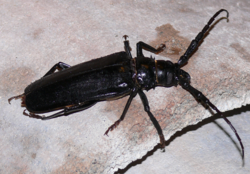- Derobrachus geminatus
-
Derobrachus geminatus 
Scientific classification Kingdom: Animalia Phylum: Arthropoda Class: Insecta Order: Coleoptera Family: Cerambycidae Subfamily: Prioninae Genus: Derobrachus Species: D. geminatus Binomial name Derobrachus geminatus
LeConte, 1853 [1]Derobrachus geminatus, known variously as the Palo Verde beetle, Palo Verde root borer, Palo Verde borer beetle, Elm root beetle or Prionid beetle, is a longhorn beetle native to the American Southwest and northern Mexico. It is one of the largest beetles in North America. Although the insect can cause significant damage to individual trees, the damage is mechanical rather than fungal, and should not be confused with Dutch Elm Disease in which one of several beetles of the family Curculionidae transmit pathogenic ascomycete microfungi of the genus Ophiostoma from tree to tree.
Derobrachus hatches from eggs into grubs, which live underground for as many as three years; as a result, the huge but harmless grubs can be uncovered by gardeners doing routine yard maintenance, especially in flower beds surrounding lawns which contain susceptible trees. The larvae are cream colored to pale green, typically with a brown headcap, and feed on the roots of trees, causing branch dieback. In the wild the most commonly affected tree is the Mexican Palo Verde ('Parkinsonia aculeata'), although wild specimens of other types of palos verdes (P. florida, P. microphylla and P. sonorae among the most common) are attacked as well.
In cities and other domesticated developments (such as parks, college campuses, cemeteries and the like) the absence of sufficient Parkinsonia species has evoked in the beetle a tolerance for a highly cosmopolitan diet, including the Siberian elm (do not confuse Derobrachus with the Elm Leaf Beetle, which see), white and fruitless mulberry, various cottonwoods and, in the warmest desert areas, citrus. As a result, in cities such as Las Vegas and Albuquerque, which are generally too cold for wild palos verdes to survive (although in Las Vegas such trees introduced into the landscape can thrive) the insect is commonly known as the elm root borer, since its three-quarters to one inch diameter exit holes are commonly seen around the bases of afflicted Siberian elms[2].
Mature borer beetles look like a large cockroach. They can grow six to eight inches, have long antennae, and spines on the thorax which form a collar around the "neck" of the beetle. They range from brown to black in color. They have wings and can fly, albeit awkwardly at times. The adults lay eggs in the soil. Adult beetles come out in the summer time, especially in the early evening when attracted by outside lighting. Afflicted specimens may not be noticed until it is far too late to do anything about the infestation. Treatment is difficult under the best circumstances, since the insect's preferred food is the root. By the time significant branch dieback is visible to the casual viewer, the amount of damage it mirrors is almost certainly beyond the fatal stage.
References
- ^ "Derobrachus geminatus". Integrated Taxonomic Information System. http://www.itis.gov/servlet/SingleRpt/SingleRpt?search_topic=TSN&search_value=702666.
- ^ general-at-generalexterminating.com (2009). "Palo Verde Borer or Prionid" (in EN). Insects & Pests. General Exterminating, Inc, 12040 N 111th Ave, Youngtown, AZ 85363. http://generalexterminating.com/component/content/article/41/77-palo-verde-borer-or-prionid-.html. Retrieved 2011-07-20.
External links
- About.com:Phoenix Arizona
- A picture of the Palo Verde borer beetle
- The University of Arizona. Palo Verde borer beetles in the low desert
- Bug Guide. Palo Verde root borer.
- Taxonomy Browser. Derobrachus geminatus

This longhorn beetle article is a stub. You can help Wikipedia by expanding it.
